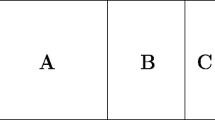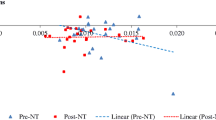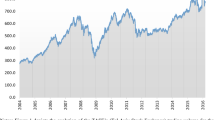Abstract
Market efficiency implies that the risk-adjusted returns from holding stocks during regular trading hours should be indistinguishable from the risk-adjusted returns from holding stocks outside those hours. We find evidence to the contrary. We use broad-based index exchange-traded funds for our analysis and the Sharpe ratio to compare returns. The magnitude of this effect is startling. For example, the geometric average close-to-open (CO) risk premium (return minus the risk-free rate) of the QQQQ from 1999–2006 was +23.7 per cent whereas the average open-to-close risk premium was −23.3 per cent with lower volatility for the CO risk premium. This result has broad implications for when investors should buy and sell broadly diversified portfolios.

Similar content being viewed by others
Notes
As discussed below, OC returns are already equal to risk premia as the two trades required to realize the return settle on the same day.
Using intraday data for an equally weighted index of NYSE-listed stocks from September 1971 to February 1972 and the calendar year 1982, Wood et al (1985) show that CO returns account for two-thirds of close-to-close returns in the 1971–1972 period, yet in 1982, CO returns account for a percentage that is not statistically different from zero.
For the analysis using CRSP prices, the open and close prices are used directly from the CRSP database; however, there are several dates in which prices are missing. The missing close prices were replaced after consultation with CRSP employees. Several missing open prices were replaced by taking the first trade of the day from the TAQ data. The first trade price on the composite tape corresponds closely to the CRSP open price for most of 1994–2006. The TAQ data were cleaned by removing all coded trades as well as removing price jumps. Few removed trades occurred during the 5 min VWAP period.
We use the term ‘composite’ to refer to the price series from all exchanges. The ‘Amex’ price series only includes prices for trades executed on the American Stock Exchange.
We wish to thank J.D. Opdyke for providing SAS code to implement his method. The code is available from www.DataMineIt.com.
Opdyke (2007) only rigorously proves the validity of the asymptotic variance formula for the two-sample test in the iid case, although he conjectures that it is also valid under the more general conditions of stationarity and ergodicity. Given that our point estimates of XSRs are all positive for CO returns and all negative for OC returns, we also conduct one-sample tests (for which Opdyke's variance formula is known to be valid given only stationarity and ergodicity) of H0, CO: XSR(1)⩽0 versus Ha, CO: XSR(1)>0 and of H0, OC: XSR(2)⩾0 versus Ha, OC: XSR(2)<0. We can reject H0, CO at the 1 per cent level for all five ETF return series and we can reject Ha, CO at the 5 per cent level for QQQQ and MDY. We are therefore confident in the significance of our two-sided test results reported in Table 2c.
References
Barberis, N., Shleifer, A. and Vishny, R. (1998) A model of investor sentiment. Journal of Financial Economics 49 (3): 307–343.
Bloomfield, R. and Hales, J. (2002) Predicting the next step of a random walk: Experimental evidence of regime-shifting beliefs. Journal of Financial Economics 65 (3): 397–414.
Branch, B. and Ma, A. (2006) The overnight return, one more anomaly. SSRN, http://papers.ssrn.com/sol3/papers.cfm?abstract_id=937997.
Broom, K., Van Ness, R. and Warr, R. (2007) Cubes to quads: The move of QQQ from AMEX to NASDAQ. Journal of Economics and Business 59 (6): 520–535.
Cliff, M., Cooper, M. and Gulen, H. (2008) Return differences between trading and non-trading hours: Like night and day. SSRN, http://ssrn.com/abstract=1004081.
Fenton-O'Creevy, M., Nicholson, N., Soane, E. and Willman, P. (2005) Traders: Risks, Decisions, and Management in Financial Markets. New York: Oxford University Press.
Goldberg, D. and Lupercio, A. (2004) Cruising at 30,000: Semi-Pro Numbers Level Off, but Trading Volumes Rise. Bear Stearns Equity Research.
Hansen, B. (1994) Autoregressive conditional density estimation. International Economic Review 35 (3): 705–730.
Hasbrouck, J. (2003) Intraday price formation in US equity index markets. Journal of Finance 58 (6): 2375–2399.
Hong, H. and Wang, J. (2000) Trading and returns under periodic market closure. Journal of Finance 55 (1): 297–354.
Jobson, J. and Korkie, B. (1981) Performance hypothesis testing with the Sharpe and Treynor measures. Journal of Finance 36 (4): 889–908.
Lakonishok, J. and Levi, M. (1982) Weekend effects on stock returns: A note. Journal of Finance 37 (3): 883–889.
Madhavan, A. and Panchapagesan, V. (2002) The first price of the day: Auctions are not practical for trading all securities. Journal of Portfolio Management 28 (2): 101–111.
Meziani, S. (2005) Exchange Traded Funds as an Investment Option. New York: Palgrave Macmillan.
Miller, E. (1989) Explaining intra-day and overnight price behavior. Journal of Portfolio Management Summer 15 (4): 10–16.
Nguyen, V., Van Ness, B. and Van Ness, R. (2006) Inter-market competition for exchange traded funds. Journal of Economics and Finance 31 (2): 251–267.
Opdyke, J. (2007) Comparing Sharpe ratios: So where are the p-values? Journal of Asset Management 8 (5): 308–336.
Sharpe, W. (1966) Mutual fund performance. Journal of Business 39 (1): 119–138.
Sharpe, W. (1994) The Sharpe ratio. Journal of Portfolio Management 21 (1): 49–59.
St. Louis Federal Reserve. (2007) St. Louis Fed: Economic data – FRED. June 2007, http://research.stlouisfed.org/fred2/, accessed 20 June 2007.
Stoll, H. and Whaley, R. (1990) Stock market structure and volatility. The Review of Financial Studies 3 (1): 37–71.
Treynor, J. (1965) How to rate management of investment funds. Harvard Business Review 43 (1): 63–75.
Whitelaw, R. (1997) Time-Varying Sharpe Ratios and Market Timing. New York: NYU Stern School of Business. NYU Working Paper no. FIN-98-074.
Wood, R., McInish, T. and Ord, K. (1985) An investigation of transaction data for NYSE stocks. Journal of Finance 40 (3): 723–739.
Acknowledgements
The authors thank Thuy Lan Nguyen for research assistance. The authors wish to thank the members of the Lafayette College NERDS seminar series for useful comments.
Author information
Authors and Affiliations
Corresponding author
Appendix
Appendix
AR(p)-SKEW-t-GARCH ESTIMATION PROCEDURE
We begin by estimating the conditional mean of the daily excess return as an AR(p) process (with a constant) where the order, p, is chosen as follows. We start with p=1, estimate an AR(1) model and then perform a Lagrange multiplier (LM) test for the presence of autocorrelation in five lags of the residuals. Under the null of no serial correlation, the test statistic is asymptotically distributed χ2 with five degrees of freedom. If the null of no serial correlation is rejected for any of the five lags, we then increase p by one, fit an AR(p) model, and perform LM tests for autocorrelation in the residuals. The order is chosen to be the smallest p for which autocorrelation is rejected at the 5 per cent level in all five lags. We then estimate a skew-t-GARCH(1, 1) model for the conditional variance of the AR(p) residuals. Specifically, if y t is the excess return on day t, then

where ɛ t =σ t z t with

and z t has a standardized skewed Student-t distribution. That is, z t has density function

where ν denotes the degrees of freedom, γ is the asymmetry parameter

and

where Γ is the gamma function. See Hansen (1994) for additional details on the skewed Student-t distribution.
Rights and permissions
About this article
Cite this article
Kelly, M., Clark, S. Returns in trading versus non-trading hours: The difference is day and night. J Asset Manag 12, 132–145 (2011). https://doi.org/10.1057/jam.2011.2
Received:
Revised:
Published:
Issue Date:
DOI: https://doi.org/10.1057/jam.2011.2




